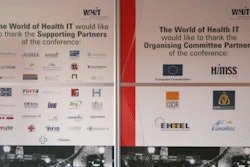The countries of Europe have led the world in adopting electronic record keeping for healthcare. But even European healthcare organizations remain light years behind other industries in 21st century information technology utilization, as a new multicountry study from BMC Medical Informatics and Decision Making reinforces.
The study findings imply that a major cultural change is needed by healthcare IT departments for these organizations to succeed in adopting the most efficient level of digital records management. It is a sobering reminder that even well-planned initiatives face major obstacles for successful deployment. (BMC Med Inform Decis Mak, 21 December 2011, Vol. 11:76).
Researchers from UMIT -- Private University for Health Sciences, Medical Informatics and Technology in Hall/Tyrol, Austria, contacted IT departments in nearly 200 hospitals in five countries between April and October in 2008 to determine their level of understanding, interest, and implementation of IT-based service processes in healthcare organizations. The majority of hospital IT department managers reported that the priority of their departments were to be technology providers, not service providers, to their constituencies. Very few responders had implemented IT service programs either.
International IT service management programs
Service management programs are an intrinsic component of IT infrastructure in most industries. They are based on ISO/IEC 20000, the first international standard for IT service management. The Information Technology Infrastructure Library (ITIL) Version 3, a set of good practices for IT service management, is equivalent to the scope of ISO/IEC 20000.
ITIL provides a framework for identifying, planning, delivering, and supporting IT services to businesses. It offers guidance on how to use IT as a tool to facilitate business change, transformation, and growth through descriptions of procedures, tasks, and checklists. Companies and organizations using ITIL can establish a baseline to demonstrate compliance and measure improvement.
Its benefits include improved IT services, better use of human and IT resources, reduced costs, enhanced productivity, and improved customer satisfaction. Such benefits are important to healthcare organizations that want innovative IT-based service processes, and are making huge capital investments to acquire them.
The study
The question asked by principal investigator Dr. Alexander Hörbst, head of UMIT's research division ehealth and telemedicine, and colleagues, was the extent to which hospital IT departments had adopted IT service management, specifically ITIL. They selected 196 hospitals located in Austria, Bavaria in Germany, Slovakia, the province of South Tyrol in Italy, and Switzerland. The research team analyzed the structural distribution of existing hospitals based on type of hospital, bed size, ownership, and the area of responsibility.
The largest hospitals with respect to bed size and areas of responsibility in a combined geographic region of 34 million inhabitants were selected. These included the following:
- 45 hospitals in Austria, five from each federal state and all university hospitals
- 35 hospitals in Bavaria, five from each of its administrative regions
- 33 hospitals randomly selected from eight regions, including all nine university hospitals in Slovakia
- All seven hospitals in South Tyrol
- 78 hospitals in Switzerland, three from each canton and all five university hospitals
- Interviews with the heads of the hospitals' IT departments were conducted in person, by telephone, and/or online by a single interviewer for each country or region. The interviews lasted up to an hour.
The responses
A total of 75 organizations provided valid data, representing a response rate of 47.5%.They included an even distribution of general, specialized, and university hospitals. The majority (59%) of the organizations were public hospitals, and their bed size was also evenly distributed, from fewer than 300 beds to more than 900 beds.
All but 5% of the hospitals operated central IT departments. About half of the hospitals provided in-house services. Respondents from Slovakia reported the largest percentage of outsourced IT services at 13%, and Bavarian hospital respondents did no outsourcing whatsoever.
Hospital budgets for IT department activities in 2008 ranged from less than 1% to more than 4%. Thirty-five percent of the total reported a budget of 1% to 2%, with the lowest IT budgets reported in Slovakia and South Tyrol. Approximately 60% had implemented an IT strategy, with the lowest percentage in Austria at 38%.
Familiarity with IT service management programs averaged 55%. German respondents ranked highest, at 92%, and Slovakian respondents ranked lowest at 17%. Familiarity with ITIL ranked from a high of 85% in Bavaria to a low of 13% in Slovakia.
The number of hospitals with ITIL-certified employees was unimpressive. Only 14 hospitals reported having any. Only five hospitals had implemented any part of ITIL, and only eight hospitals planned to implement one or more elements of ITIL over the next 24 months. Two-thirds of the respondents reported that they had other priorities, 17% had no motivation to do so, and 13% lacked the budget.
Overall, ITIL implementation was not on the radar for two-thirds of the hospitals, and represented a much lower adoption rate than by other organizations located in their geographic regions. When asked what would lead to the introduction of ITIL, the need to provide better IT service represented the largest response, followed by the need to increase productivity.
Concerns
While acknowledging that the momentum to adopt electronic health records (EHRs) has climbed steadily in the past five years since this the survey was conducted, Hörbst and colleagues concluded that hospital IT departments primarily identified themselves as providers of technology, rather than as service providers using technology as a tool.
This opinion must change if complex healthcare scenarios involving multiple entities and information systems are to succeed, according to Hörbst. He pointed out that healthcare is facing an ever-increasing proliferation of technology in daily operation, some of which, such as EHRs, cross organizational boundaries.
"The way that IT is managed in healthcare organizations, IT departments are predominantly providers of IT components. They do not offer a service catalog where IT components are part of certain services offered. In order to be able to offer reliable, complex, and high-quality IT services such as electronic health records, it is necessary to transparently and rigidly manage IT within healthcare organizations," Hörbst told AuntMinnieEurope.com.
"As governments or national departments are increasingly discovering the potential of healthcare IT to increase quality and reduce costs, the concepts of ITIL are even more important as they increase transparency and interoperability on a managerial level. ITIL, which represents best practices and internationally adopted IT standards, can be regarded as an important enabler to reach goals, and contribute to the successful establishment of EHRs and other systems," he said.
"A mental shift is necessary by IT departments and hospital administrators. IT must be an integral part of the service provision in healthcare, not just supportive," he concluded.



















